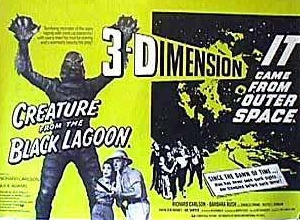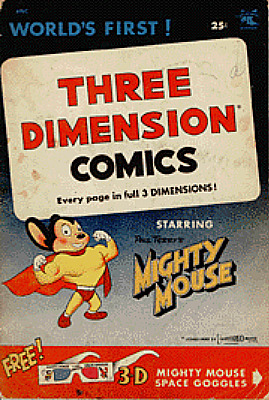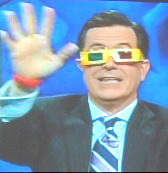3D in Hollywood has had more incarnations than the “Saw” and “Friday the 13th” movie franchises.
The latest revival finds nearly all animated movies from Disney/Pixar, DreamWorks, and others being released in 3D, while format standards and specifications are being quickly developed by the home video, TV, videogame, and Internet industries to offer high quality 3D in the home for the first time beginning in 2010.
The following is a summary of the history and various technologies of 3D, as well as some key term definitions (interwoven and at end), with much historical and technical information sourced from Wikipedia.
A modern (19th century) marvel
Various stereoscopic motion picture systems have been around since the 1890s, with one 3D short even getting an Oscar nomination as far back as 1936.
The first 3D movie presented to a paying audience – “The Power of Love,” at the Ambassador Hotel in Los Angeles on Sept. 27, 1922 – used the system called “anaglyph” that would become the primary cinema 3D format 50 years later and last for decades from the 1970s into the mid-2000s and is still used today for some DVDs and TV broadcasts.
Anaglyph: two images superimposed through two filters, one red and one blue (cyan). Glasses with corresponding colored lenses for each eye separate the appropriate images by canceling the filter color out and rendering the complementary color black.
Another anaglyph system for NTSC broadcast TV called ColorCode 3-D uses yellow and dark blue on-screen, and the colors of the glasses’ lenses are amber and dark blue.
Louis Lumiere shot footage in Paris with his stereoscopic camera in 1933 and premiered his remake of his 1895 film “L’Arrivée du Train” in anaglyphic 3D in March 1934.
In 1936, MGM released the black-and-white short “Audioscopiks” in red/green anaglyph format with prints by Technicolor on January 11, 1936. It was nominated for an Academy Award for Best Short Subject, Novelty.
Post-war 3D boom: the 1950s
 Most people of a certain age are familiar with the surge of 3D movies in 1952-53, beginning with “Bwana Devil” (shot in the Natural Vision process), Warner Bros.’ Vincent Price cult classic “House of Wax” and John Wayne’s “Hondo,” Universal’s “It Came From Outer Space,” and MGM’s “Kiss Me Kate.”
Most people of a certain age are familiar with the surge of 3D movies in 1952-53, beginning with “Bwana Devil” (shot in the Natural Vision process), Warner Bros.’ Vincent Price cult classic “House of Wax” and John Wayne’s “Hondo,” Universal’s “It Came From Outer Space,” and MGM’s “Kiss Me Kate.”
The Three Stooges also got into the 3D act in 1953 with their 148th and 149th shorts “Spooks!” and “Pardon My Backfire.”
And Paramount even released animated shorts in 3D during this period featuring Popeye the Sailor (“Popeye, Ace of Space”) and Casper the Friendly Ghost (“Boo Moon”).
Two of the most-remembered 3D movies of the era came in 1954: Alfred Hitchcock’s “Dial M for Murder” and “Creature from the Black Lagoon” (and a rare 3D sequel “Revenge of the Creature” in 1955).
The re-introduction of cinematic 3D at that time was one of many efforts by the movie theater industry to try to combat the frightening competition of television by creating bigger and more dynamic cinematic experiences, including widescreen innovations such as Cinerama, Todd-AO and Cinemascope.

But the 3D craze of the early 1950s using primarily the polarization process was short-lived because two films needed to be projected precisely simultaneously. Any deviation, including repairs to one print and not the other, caused the films to be out of synch, ruining the effect and creating an unpleasant experience for the audience.
Also, the silver screens required for this 3D process were so directional that patrons sitting at the sides of the auditorium could not experience the effect.
It’s a broad misconception that this was a period in which audiences donned the iconic red/cyan glasses in movie theaters. In fact, the cheesy cardboard glasses that fold flat were introduced during this same period as gimmicks for comic books printed in 3D, such as the one pictured at left.
Sex, horror, and 3D in the 1970s
With the creation of a 3D process called Stereovision, 3D made something of an inauspicious comeback in the 1970s beginning with the soft-core sex comedy “The Stewardesses.” The $100,000 novelty production played in about 800 drive-in movie theaters and other cinemas for nearly a year, racking up $27 million in North America to become the most profitable 3D film up to that point. (A remake was slated for release in 3D in 2009.)
A couple dozen Stereovision 3D films were released shortly after “The Stewardesses” but most were limited to the softcore porn and horror genre, including “Flesh for Frankenstein” (aka “Andy Warhol’s Frankenstein”).
Stereovision: a 35 mm single-strip format created in 1970 that printed two images squeezed side-by-side and used an anamorphic lens to widen the pictures through polaroid filters.
Another decade, another 3D revival: the early 1980s
 The first notable 3D film of the decade came in 1981 with the independent Western “Comin’ at Ya!,” which introduced most modern audiences to their first experience using glasses with the dark polarized lenses.
The first notable 3D film of the decade came in 1981 with the independent Western “Comin’ at Ya!,” which introduced most modern audiences to their first experience using glasses with the dark polarized lenses.
The film used a process also developed in the 1970s similar to Stereovision with the separate images printed on a single frame above each other, called the “over and under” process. The camera system called the Marks 3-Depix StereoSpace Converter required a companion projector with a 3-Depix Reverser. Producer and co-star Tony Anthony developed a relatively low cost projection lens which made the film marketable for general release.
With sequels and “franchises” becoming the popular craze of the risk-averse movie industry of the 1980s, and a nearly bankable percentage decline with each successive installment, Hollywood once again called on 3D as a gimmick to resuscitate fading cinematic series such as Friday the 13th Part 3-D (1982) and Jaws 3-D and Amityville 3-D (1983).
Although the lenses were dark instead of colors, the cardboard glasses in this era were not much more substantial than those found in comic books in the 1950s. They seemed as cheesy as the movies.
Thus, the latest 3D fad came and went quickly once again.
Space-Vision / “Over and Under”: Stereoscopic films printed with two images, one above the other, in a single academy ratio frame, on a single strip, requiring only one projector fitted with a special lens, and producing widescreen, but darker, less vivid, polarized 3-D images.
Polaroid: Since the 1980s, the anaglyph 3D system has been superseded in popularity by the polarization 3D system, which presents a more life-like image with less eye-strain over longer periods of time.
Edwin H. Land invented Polaroid filters for 3D photography, first demonstrated in January 1936 in New York and used later that year in 3D movies in Italy and Germany.
Movies that use polarized light do not register on a matte white screen and so require a silver screen that will correctly reflect the separate images.
During projection, the left and right eye images are polarized perpendicular to one another (or right-hand and left-hand circular polarization is used) as they are projected. By wearing special eyeglasses with lenses polarized in their respective directions to match the projection, the left eye image can be viewed only by the left eye since the polarization of the left lens will cancel out that of the right eye projection, and vice-versa with the right eye image.
A recurring theme (park): 3D – the mid-to-late 1980s – 2000s
Walt Disney introduced 3D to Disneyland patrons as early as 1957 in a Fantasyland Theater show hosted by the Mousketeers called 3-D Jamboree that featured the 3D color short “Melody,” originally released in theaters in 1953 with the first 3D Western, Columbia Pictures’ “Fort Ti.”
Although Disney theme parks showcased many other cinematic innovations such as the 360-degree CircleVision, it would be several decades before 3D returned to the parks.
As 3D once again fell out of favor at mainstream movie houses, it was theme parks, led by Disney, that introduced and showcased the most advanced 3D viewing environments with the latest polaroid technology and theaters customized for optimum viewing. Many also included immersive audience experiences, from actors running on stage and seemingly into the movie itself (“T2: 3-D”) to vibrations in seats and even water spray and fog machines to enhance the feeling of 3D.
Several have been among the most popular attractions at the parks.
 • Michael Jackson’s “Captain EO” premiered at Disneyland and Disney World’s Epcot Center in September 1986. The 17-minute futuristic fantastical story in a sort of long-form music video from Francis Ford Coppola and George Lucas cost $30 million to produce, the most expensive ever at that time, at $1.76 million per minute.
• Michael Jackson’s “Captain EO” premiered at Disneyland and Disney World’s Epcot Center in September 1986. The 17-minute futuristic fantastical story in a sort of long-form music video from Francis Ford Coppola and George Lucas cost $30 million to produce, the most expensive ever at that time, at $1.76 million per minute.
• “Honey, I Shrunk the Audience!” debuted at Walt Disney World’s Epcot Center in 1994.
• “T2 3-D: Battle Across Time” was introduced at Universal Studios Florida in spring 1996 (and May 1999 at Universal Studios Hollywood) as one of the most expensive attractions ever at a cost of $60 million, including $24 million for the 12-minute film.
The unique forma used six solid-state Electrosonic projectors showing 70mm films simultaneously and in synch at 30 frames-per-second onto three adjoined silver screens.
• The nine minute “It’s Tough to be a Bug!” debuted at Walt Disney World’s Animal Kingdom in April 1998.
• The “Shrek 4-D” film/ride opened at Universal Studios Hollywood in 2003.
3D to the IMAX: the 1980s – 2000s
In the 1980s, IMAX large-format theaters began offering non-fiction films in 3D, starting with the 20-minute National Film Board of Canada production “Transitions,” originally created for Expo 86 in Vancouver. Dozens of documentaries have been presented in IMAX 3D since, many of them with underwater themes, including the recent “Under the Sea.”
The first IMAX 3D fiction film was the 45-minute “Wings of Courage” in 1995, which used the “over-under” process pioneered by Space-Vision.
In the 2000s, many 3D movies released in conventional theaters in the RealD 3D process were simultaneously released in IMAX 3D, including “The Polar Express” (2004), “U2: 3D” (2008), and DreamWorks’ “Monsters vs. Aliens” and Disney’s “A Christmas Carol” in 2009.
3D in the 21st Century: the 2000s
Although there were a smattering of 3D movies released in the late 1990s and early 2000s, including the Robert Rodriguez family adventure “Spy Kids 3D” (2003), most recently interest in 3D movies was reignited first by the release of the Robert Zemeckis motion-capture movie “The Polar Express” in IMAX 3D theaters in 2004, and particularly the introduction of digital projection. Disney’s “Chicken Little” in 2005 was the first digitally-projected 3D feature. Disney also struck gold with the studio’s lucrative 3D conversion and re-release of the 1993 “The Nightmare Before Christmas” in 2006.
After a few 3D movies scattered throughout 2006-2008, including Disney’s “Bolt” and Warner’s very successful “A Journey to the Center of the Earth” in 2008, by 2009 Disney/Pixar and DreamWorks began releasing virtually all of their animated movies in 3D, with Disney’s line-up including “Up,” 3D conversions of “Toy Story” and “Toy Story 2,” and the Zemeckis motion-capture film “A Christmas Carol.”
After experimenting with 3D documentaries such as “Ghosts of the Abyss” and “Aliens of the Deep” during a 12-year self-imposed absence from theatrical fictional features after his box-office blockbuster “Titanic” on Dec. 19, 1997, James Cameron made his return to Hollywood with the 3D epic fantasy “Avatar” on December 18, 2009.
Dozens of movies were slated for release in 3D in 2010, including “Toy Story 3” and conversions of movies such as “Beauty and the Beast.”
3D glasses
• Liquid crystal shutter: Glasses containing liquid crystal and a polarizing filter have properties that become dark when voltage is applied, but otherwise is transparent. The glasses alternately darken over one eye, and then the other, in synchronization with the refresh rate of the screen, while the display alternately displays different perspectives for each eye, using a technique called Alternate-frame sequencing.
• Linear polarized: contain a pair of orthogonal polarizing filters. As each filter only passes light which is similarly polarized and blocks the orthogonally polarized light, each eye only sees one of the images, and the effect is achieved. Viewer required to keep his head level, as tilting of the viewing filters will cause the images of the left and right channels to bleed over to the opposite channel.
• Circularly polarized: contain a pair of analyzing filters (circular polarizers mounted in reverse) of opposite handedness. Light that is left-circularly polarized is extinguished by the right-handed analyzer; while right-circularly polarized light is extinguished by the left-handed analyzer. The result is similar to that of stereoscopic viewing using linearly polarized glasses; except the viewer can tilt his head and still maintain left/right separation. (The Real D Cinema system uses an electronically driven circular polarizer, mounted in front of the projector and alternating between left- and right- handedness, in sync with the left or right image being displayed by the (digital) movie projector. The audience wears passive circularly polarized glasses.)
• Infitec: acronym for Interference Filter Technology, referring to special interference filters in the glasses and in the projector which divide the visible color spectrum into six narrow bands – two in the red region, two in the green region, and two in the blue region. One of each color are used for one eye image, and the other three for the other eye. The human eye is largely insensitive to such fine spectral differences so this technique is able to generate full-color 3D images with only slight color differences between the two eyes. Sometimes this technique is described as a “super-anaglyph” because it is an advanced form of spectral-multiplexing which is at the heart of the conventional anaglyph technique.
(The Dolby 3D theater system uses a form of this technology.)
• Color anaglyph: complementary color anaglyphs employ one of a pair of complementary color filters for each eye. The most common color filters used are red and cyan. The eye is sensitive to red, green, and blue. The red filter admits only red, while the cyan filter blocks red, passing blue and green (perceived as cyan). Another recently introduced form employs blue and yellow filters (yellow is the color perceived when both red and green light passes through the filter).

Believe it or not, I think the only 3D movie I ever watched was Spacehunter, Adventures in 3D. If my friend hadn’t forced me to go, I don’t think I would’ve gone. Wait, there was one other time in the 1990s, with my wife. Can’t remember what movie : )
Ha, too funny. Well, they have already all-but died out again, although I was pleased to see the one and probably only James Bond movie in 3D last October, No Time to Die, which was amazing: http://hollywoodinhidef.com/2021/10/first-007-in-3d-is-the-reald/